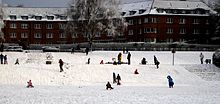Gate of hope
The Gate of Hope is a listed residential complex with an associated park in Lübeck . It is located in the St. Gertrud district in the Marli district, right on the banks of the Wakenitz .
history
Rodolfo Groth , who was born in Lübeck , acquired an extensive piece of land in 1936 with a slope gently sloping towards the river bank on the east bank of the Wakenitz , not far from the city center . His intention was to build an exemplary residential complex for his hometown, which at the time was suffering from a severe housing shortage. Groth entrusted the Lübeck architect Willy Glogner with the planning .
Within a year - the topping-out ceremony was celebrated on February 23, 1937 - a three-storey complex with 46 apartments was built, which opens in a wide arc towards Wakenitz and at the ends of which are two side wings. The central axis is a one-and-a-half storey high central gate passage with a barrel vault , through which one looks from Rudolf-Groth-Straße over the Wakenitz to the city silhouette with the Marienkirche . The brick building is stylistically based on the language of form of brick expressionism , without going into the architectural tendencies of National Socialist architecture .
On the Wakenitz side, above the gate passage, there is the inscription What is also great to experience / To make other people happy is the best . Towards Rudolf-Groth-Straße the inscription reads If a hope fails you never fail to hope / If a gate is closed, a thousand others are open . Above it is the name of the building, flanked on the left by the Olympic rings and the words Olympic year 1936 . The counterpart to the right are the Lübeck double-headed eagle and the Prussian eagle with the words Integration Lübeck-Prussia 1937 , which refer to the loss of Lübeck statehood . National Socialist symbolism is nowhere to be found. Inside the doorway, a plaque commemorates the client Rodolfo Groth. The building was listed as a historical monument in 2002.
The radio play producer Heikedine Körting spent her childhood in the Gate of Hope.
The park
Together with the building site for the residential complex, Rodolfo Groth acquired the land down to the banks of the Wakenitz and had a public park laid out there, which he donated to the city after completion and which is seen as part of the entire complex, the Gate of Hope .
In the post-war period , the green space was parceled out and converted into allotment gardens for self-sufficiency with food. In 1952 the park was restored. In 1972 the city of Lübeck planned to build on part of the attractively located park property, but this could be prevented by the citizens' initiative Rettet das Grün am Tor der Hoffnung , which was largely run by Lübeck pastor Jürgen Reuss.
literature
- Antje Kathrin Grassmann (ed.): Lübeck-Lexikon - The Hanse City A to Z . Verlag Schmidt-Römhild, 2006, ISBN 3-7950-7777-X
- Uwe Müller: St. Gertrud - Chronicle of a suburban residential and recreation area . Archives of the Hanseatic City of Lübeck, 1986
- Hartwig Beseler / Klaus Detlefsen / Kurt Gelhaar: Architecture in Schleswig-Holstein 1900–1980 . Karl Wachholz Verlag, 1980, ISBN 3-529-02660-3
Web links
Individual evidence
- ↑ A quote from Friedrich Rückert : Wisdom of the Brahman. A didactic poem in fragments. Volume 6, Leipzig 1839, p. 98 (No. 57), actually If hope fails you, you never fail to hope! A gate is closed, but a thousand are still open.
- ↑ Josephine Andreoli: A day of neverending stories . In: Lübecker Nachrichten . September 12, 2017, p. 11.
- ^ NDR: Heikedine Körting - Queen of the radio play
Coordinates: 53 ° 52 ′ 5.7 " N , 10 ° 42 ′ 37.9" E




